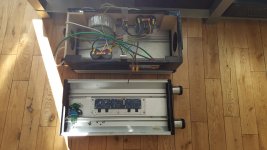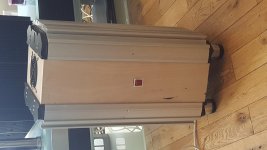Would be interesting to compare both tubes with the I version having a reduced heater voltage to run both with the 4.7 W nominal heater power of the 'normal' 6N6P. Maybe sonics get more similar then.
Well, the original schematics I'm using is based on normal 6N6P tubes and I'll just put the 6N6P-I-s into that so they will operate to normal 6N6P specs. I'm curious too.. parts are ordered, chassis is still missing, I'm trying to do my best and hurry up a bit with the project.
To run them with 'equal' heating power, the heater voltage must be reduced to 5.7V instead of 6.3V. This will reduce heating power and run the 6N6P-I cathode at comparable temperatures to the 6N6P at nominal 6.3V. On the operating points nothing will change with slightly reduced heater power as the higher pulse current is not required anyway.
To run them with 'equal' heating power, the heater voltage must be reduced to 5.7V instead of 6.3V. This will reduce heating power and run the 6N6P-I cathode at comparable temperatures to the 6N6P at nominal 6.3V. On the operating points nothing will change with slightly reduced heater power as the higher pulse current is not required anyway.
Great tip, vielen Dank ! Would you employ a switch (between 5.7 and 6.3) or just configure the whole to 5.7V ? (For both 6N6P and 6N6P-I heating voltage is given as 5.7V-7V), but with a 6N6P-I optimized 5.7V heating circuit I would be at the minimum (for both).
It's not a big deal to have a switch between 5.7 (6N6P-I) and 6.3V (6N6P) but I'm not sure I have to care of it at all.

The most simple way would be to add a 1Ohm series resistor between 6.3V supply and 6N6P-I heater. This resistor will lead to reduced power and can be operated by a simple switch on the fly. If you run both types at 5.7V, the 6N6P will then have again lower heater power compared to the 6N6P-I
Would be interesting to compare both tubes with the I version having a reduced heater voltage to run both with the 4.7 W nominal heater power of the 'normal' 6N6P. Maybe sonics get more similar then.
Very interesting, as soon as I have a little time I will try both,
I have a good batch of -I, it would be great also for longevity 6N6P not to run so hot!
Best Regards
Fernan
The most simple way would be to add a 1Ohm series resistor between 6.3V supply and 6N6P-I heater. This resistor will lead to reduced power and can be operated by a simple switch on the fly. If you run both types at 5.7V, the 6N6P will then have again lower heater power compared to the 6N6P-I
How about this thinking: the idea of reducing the heater voltage is in general good and prolongs lifetime of tubes as well. However, the cathode must be heated up 'til red glow else if too "cold", the cathode's electon emission layer can be damaged, again reducing the lifetime of the tube.
So there must be a good healthy compromise between these two ideas which translated into heating power is a max. 10% decrease, no more. With regards to power increasing with voltage^2, reducing heater voltage to 5.7V would cause approx. 20% heater power decrease. This is a bit too much here. Going down to 6.0V would be sufficient to really prolong 6N6P-I tube life while still satisfying the heater needs for both tube types (since 6N6P can run on 6V heating too, again getting benefits of it). So a final heater value of 6V AC should be sufficient and eliminates the need of a switch for the 2 slightly different tube types.
These are comments of an engineer I asked about the idea discussed before. Feel free to comment
Last edited:
My intention of lowering heater power for the 6N6P-I was not to change anything in lifetime - it was to check if lower heater power = lower cathode temperature may change sonics in a way to make them equal to the regular 6N6P. The 6N6P-I is intentionally designed to run with 20% more heater power than its sister 6N6P and thus with a hotter cathode (which I think is exactly the same for both types). The heater simply is designed to draw 900mA from a 6.3 V source instead of the 750mA for the non I version, and that is 20% more - the heater wire was made a little bit thicker, that's all. This was done to have a higher cathode emission for the intended pulse application (this was a pure military device for missile control). The negative impact of reduced lifetime (only 300 hrs) was of no issue for the intended application - it only had to work for half an hour max - the 6N6P-I is simply an overpowered 6N6P !
If we now reduce the heater power for the 6N6P-I by 20% we may achive a cathode temperature equal to the 6N6P at nominal 6.3V and thus same sonics and same lifetime !
If we now reduce the heater power for the 6N6P-I by 20% we may achive a cathode temperature equal to the 6N6P at nominal 6.3V and thus same sonics and same lifetime !
Friends
I built an amplifier to use tube 6CG7 which is electrically equal to 6SN7.
But in a burn-in test I put a 6N6P in place of the 6CG7 and the 6N6P played much better than all the 6CG7 from various brands I tested.
I would like to know if you made any comparisons between 6N6P and 6N6P-I, as I am interested in the results.
Thank you
Aldovan
I built an amplifier to use tube 6CG7 which is electrically equal to 6SN7.
But in a burn-in test I put a 6N6P in place of the 6CG7 and the 6N6P played much better than all the 6CG7 from various brands I tested.
I would like to know if you made any comparisons between 6N6P and 6N6P-I, as I am interested in the results.
Thank you
Aldovan
in a burn-in test I put a 6N6P in place of the 6CG7 and the 6N6P played much better than all the 6CG7 from various brands I tested.
Obviously the operating point of 6N6P is such, that it generates relatively high second harmonic distortion.
I put 6n6p in my musical fidelity tube headphone amp. I had to accomodate for higher heater current by replacing wallwart adapter with proper beefier trafo. Works fine for many years.
Did small power amp with just a pair of 6n6p on output, yes, just two triodes in parallel. It delivered over watt. Plenly for quiet fullrange as computer speakers, or headphones.
There is nice thread somewhere about otl amp with 6n6p. Was thinking about building it. But got derailed with all the jfet power amps.
Did small power amp with just a pair of 6n6p on output, yes, just two triodes in parallel. It delivered over watt. Plenly for quiet fullrange as computer speakers, or headphones.
There is nice thread somewhere about otl amp with 6n6p. Was thinking about building it. But got derailed with all the jfet power amps.
I use the 6N6P as a preamp. In the output I use 2A3 or another quality triode.
The 6N6P and 6CG7 are valves that need to work with high plate current to work in the most linear region.
Even working this way the 6N6P is superior.
As an output tube I would not use, I believe there are more recommended tubes, and I would use 6080 or 6AS7 in headphone amplifier.
The 6N6P and 6CG7 are valves that need to work with high plate current to work in the most linear region.
Even working this way the 6N6P is superior.
As an output tube I would not use, I believe there are more recommended tubes, and I would use 6080 or 6AS7 in headphone amplifier.
- Home
- Amplifiers
- Tubes / Valves
- 6N6P vs. 6N6P-I


